Let me first give you a brief historical overview in order to warm you up and to put this great recipe in a historical context. A Burgthetertorte is a renowned Austrian cake whose history spans a time period of about 140 years. The recipe was created by Demel, the famous royal court bakery of the Austrian Empire. The cake was served as an intermission snack in Burgtheater, the most prominent German language theater. Mozart and Beethoven are just some of the famous names whose work was premiered here. How’s that for a wow factor?

Now, such a special cake calls for a special occasion, so I made it for this year’s Valentine’s day! It is reading week for the Ontario universities and my students are back home. This was my present to them.
At first look the cake recipe leaves an impression of a simple and plain dessert, as many of old fashion cakes do. It has no icing on the outside of the biscuit and the only filling is a thin red currant glaze spread between the two biscuit layers. However, I had no doubt that the first impression is deceiving and that the taste must be outstanding. With the prominence the recipe had through its long stretch of history, the purpose it served at the time, and the fact the recipe still lives, assured me that this will be a good thing. And sure enough I was right, the taste was phenomenal!
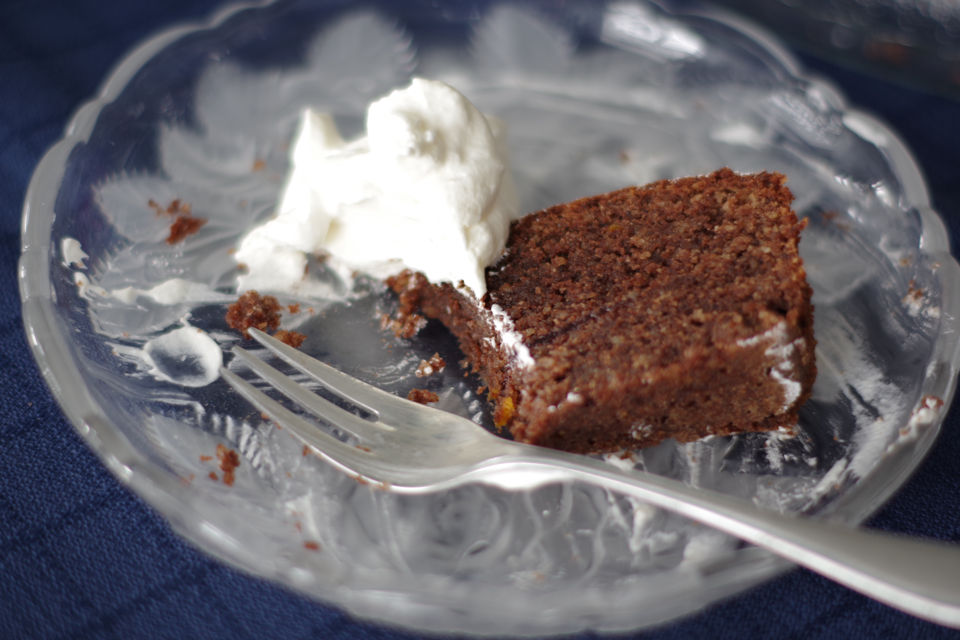
The simplest way to describe the experience is: it is a rich and moist chocolate almond cake accented with candied orange peel and red currant preserve. The key, and at the same time the largest ingredient by quantity in the recipe, are cake crumbs. This is a flour-less cake, the idea being that bakers used cake scraps from trimming that were readily available daily as an ingredient. Certainly some of those cake scraps may contained flour. But don’t let this cake scraps idea confuse you, the quality of crumbs matters! The better the crumbs, the better the cake. Since I obviously couldn’t count on cake scraps laying around, I ventured in and separately baked a chocolate sponge cake that was later converted into crumbs. It may sound like a lengthy process, but I went into it knowingly with the expectation of producing a high quality biscuit. I did not mind it and it was definitely worth it!
The cake truly wonderful! It is not too sweet, it has the moist crumb and a wonderful aroma reminiscent of Christmas fruit cake. Yes, but not a cheap fruit cake, rather a fruit cake with a flare!
I also candied my own orange peel. In the past I used to buy a commercially produced peel but never liked its bland taste and lack of aroma. It is a really easy, quick and flawless recipe. You will be rewarded with a chewy, aromatic orange peel that gives the cake a whole new dimension and a wonderful fragrant fruity note.
I served the cake with with freshly whipped vanilla cream and coffee. Truly outstanding taste and I am looking forward making it again!
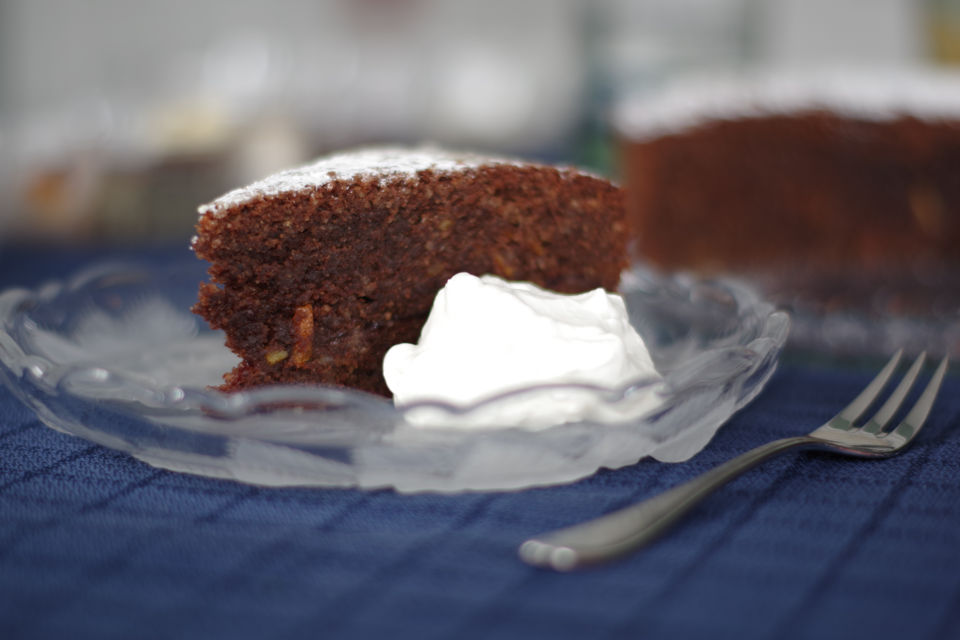
In the recipe I provided instructions how to separately prepare a Chocolate Sponge Cake that is used for crumbs and also the process of making your own candied orange peel. You can make these ahead of time or if you are not as ambitious, you can also use commercially made products. You will get out of it what you put into it!
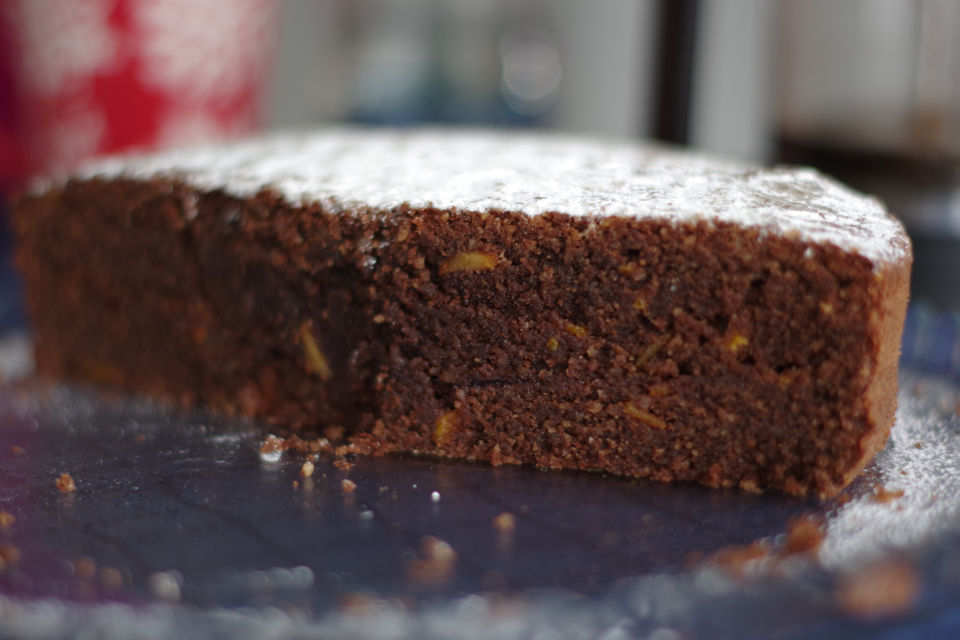
The recipe has been adapted from “Kaffeehaus – Exquisite Desserts from The Classic Cafes of Vienna, Budapest and Prague“.
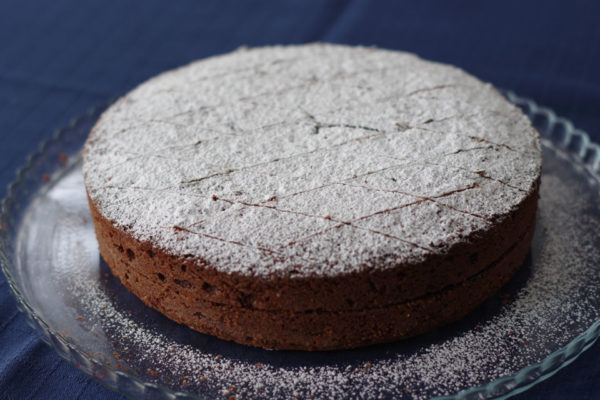
| Prep Time | 1 hour |
| Cook Time | 1 hour |
| Passive Time | 1 hour |
| Servings |
servings
|
- 4 eggs at room temperature
- 3/4 cup granulated sugar
- 3 tbsp milk
- 3 tbsp vegetable oil
- 1/2 tsp pure vanilla extract
- 2/3 cup all purpose non bleached flour sifted
- 1/4 cup unsweetened cocoa powder sifted
- 1/8 tsp sea salt
- 1 kg organic oranges
- 1/2 cup water
- 1/2 cup granulated sugar + sugar for coating
- 150 g red currant preserves
- 1 tbsp golden rum or water
- 270 g natural almonds with skin
- 2 cups confectioner's sugar + some for decorating
- 2 tbsp unsweetened cocoa powder
- 250 g unsalted butter tempered at room temperature
- 6 eggs at room temperature
- 1 tsp ground cinnamon
- 420 g chocolate cake crumbs processed in food processor
- 1/2 cup candied orange peel diced
- 150 g red currant glaze
Ingredients
Chocolate Sponge Cake (for chocolate cake crumbs)
Candied Orange Peel
Red Currant Glaze
Chocolate-Orange Cake Biscuit
|

|
- Position the rack in the center of the oven and preheat to 177°C (350°F).
- Butter a 230 mm (9") spring-form pan and line the bottom with round of parchment paper. Dust the sides with the flour and tap out the excess.
- In a medium size mixer metal or glass bowl combine together sugar and eggs.
- Place the bowl over the medium sized sauce pan with simmering water over medium heat (5 out of 10). The water should not touch the bowl. Whisk until sugar is dissolved and eggs are very warm to touch. Try to rub egg mixture between your fingers to check for grains of sugar.
- Mix at medium high speed until the mixture is tripled in volume and is very light and fluffy, about 3 minutes. Set aside.
- In a small sauce pan, heat the milk and vegetable oil until hot to touch or about 50ºC (120ºF). Stir in the vanilla extract.
- Sift together flour, cocoa and salt. Add half of the sifted mixture to the egg mixture and using a large balloon whisk gently fold it in. Add the remaining cocoa mixture and fold it in.
- Whisk a large dollop of the batter into the milk mixture. Fold this mixture back into the batter.
- Pour the batter into the baking pan and smooth the top.
- Bake until the top springs back when gently pressed in the middle, about 50 minutes.
- Cool on a wire rack for 5 minutes. Run the knife around the inside of the pan to release the cake. Remove the pan side, invert on the rack, remove the pan bottom and the paper. Re-invert the biscuit on the rack, right side up and let it cool completely.
- The cake can be prepared up to 2 days ahead. Cover tightly in plastic wrap and refrigerate.
- Using a vegetable peeler, peel the oranges. This way you will not cut too deep into white part that is bitter.
- Put the orange peel into sauce pan with cold water and bring the water to boil over high heat. Keep it at a strong boil for about 30 seconds, drain the water and then repeat the process once again, starting with the cold water.
- Over medium heat (5 out of 10) add sugar and water to the shallow pan. Stir until the sugar is dissolved.
- Add blanched and drained orange peels to the pan. Spread the peel into a single layer and let it cook until almost all water has evaporated and they almost started to crystallize. Stir frequently.
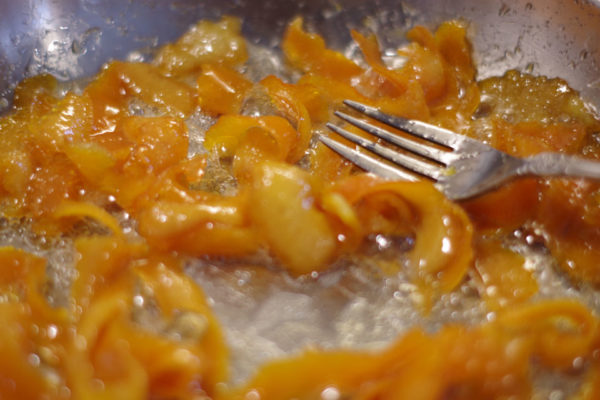
- Spread a cup of granular sugar into a wide baking pan. Transfer hot sugary orange peel and toss, coating them in the sugar. Leave the orange peel on a cooling rack for about 5 minutes. The peel will cool off fast. Do not leave it out for too long on a cooling rack or it will turn hard and brittle. Instead keep the peel in the sealed container and it will remain soft and chewy.
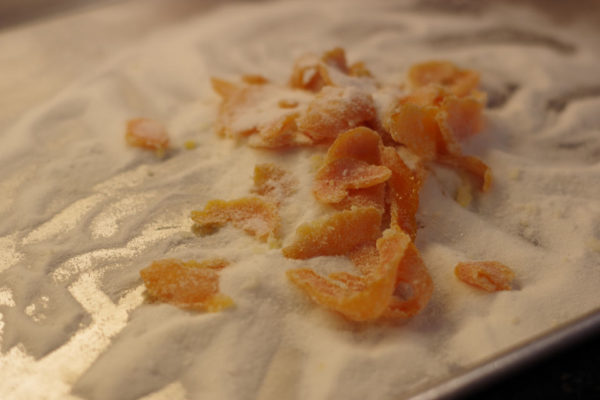
- Position the rack in the center of the oven and preheat to 177°C (350°F).
- Butter a 230 mm (9") spring-form pan and line the bottom with round of parchment paper. Dust the sides with the flour and tap out the excess.
- In a food processor, grind together almonds, cocoa and 1/4 cup of confectioner's sugar. The almonds need to be ground very fine, flour like.

- In a medium size bowl at high speed, cream softened butter for about 1 minute. Reduce the speed to low and add the remaining 1 3/4 cups of confectioner's sugar. Once it is combined, return the speed to high and mix until light and fluffy, about 3 minutes.
- Reduce the speed and very slowly mix in the eggs, one egg at the time.
- Mix in the cinnamon.
- Using a large balloon whisk, fold in almond mixture following with the cake crumbs and then diced candied orange peel.
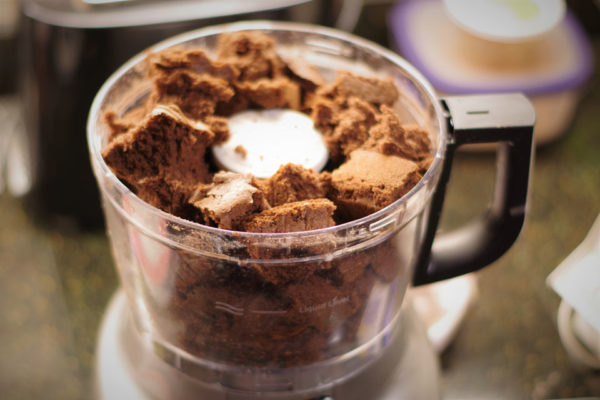
- Spread evenly into the baking pan and bake for about 1 hour or until a toothpick inserted in the center of the cake comes out clean.
- Cool on a wire rack for 5 minutes. Run the knife around the inside of the pan to release the cake. Remove the pan side, invert on the rack, remove the pan bottom and the paper. Re-invert the biscuit on the rack, right side up and let it cool completely.

- Using a cake cutting wire or a long serrated knife , cut the cake in half horizontally.
- Add the red currant preserve and rum in a small saucepan. Bring it to a boil over medium heat, stirring constantly. Continue cooking for another 3-4 minutes until glaze is very sticky. Strain the glaze through a wire sieve into a small bowl, pressing hard on solids using the back of the spoon. Spread the warm glaze evenly on bottom half of the cake. Top it up with the top cake layer.
- Sift the top of the cake generously with confectioner's sugar. Using a sharp knife create a crosshatch pattern on the top.
- Let cake stand at room temperature for at least 1 hour before serving. Store it tightly wrapped at room temperature.

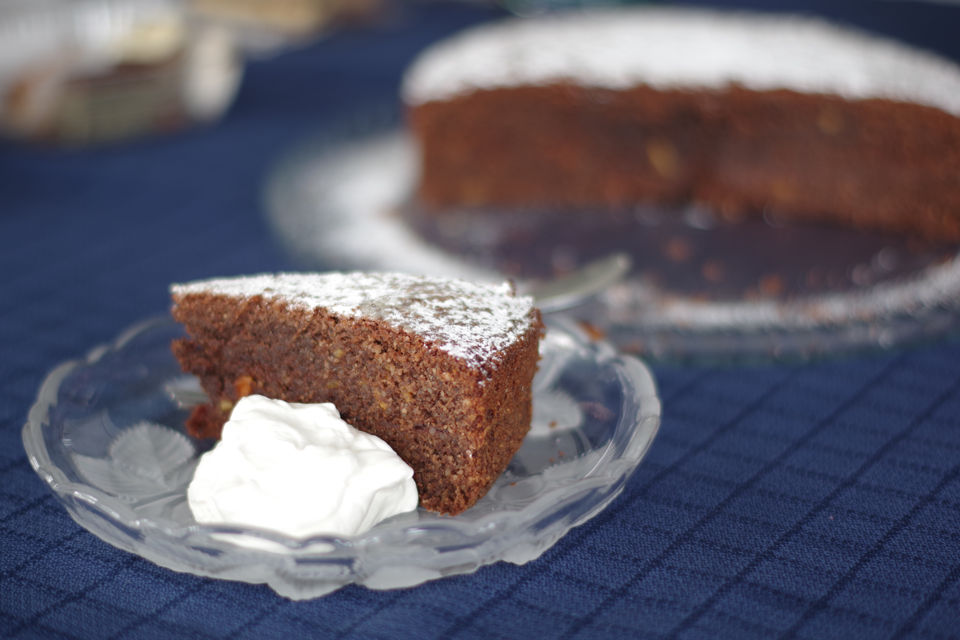
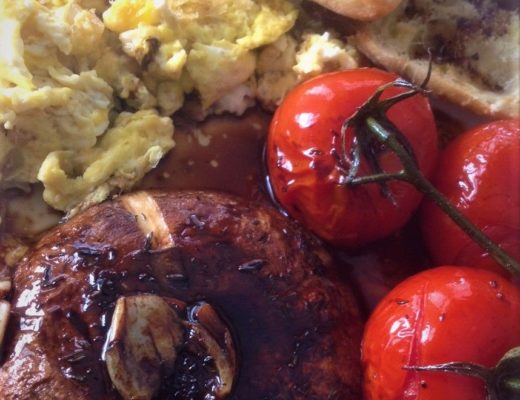
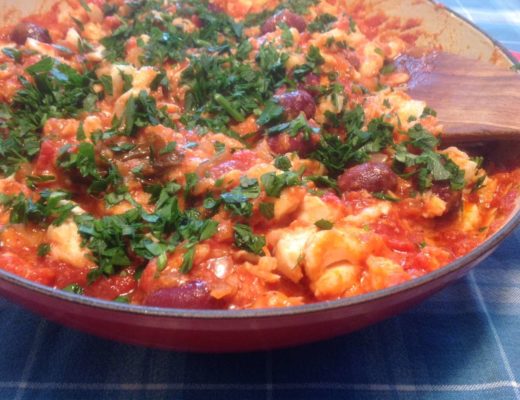
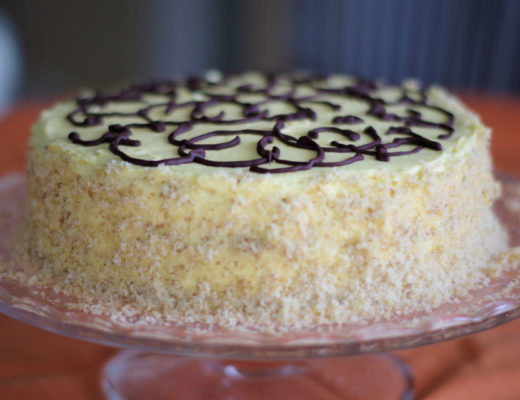
No Comments